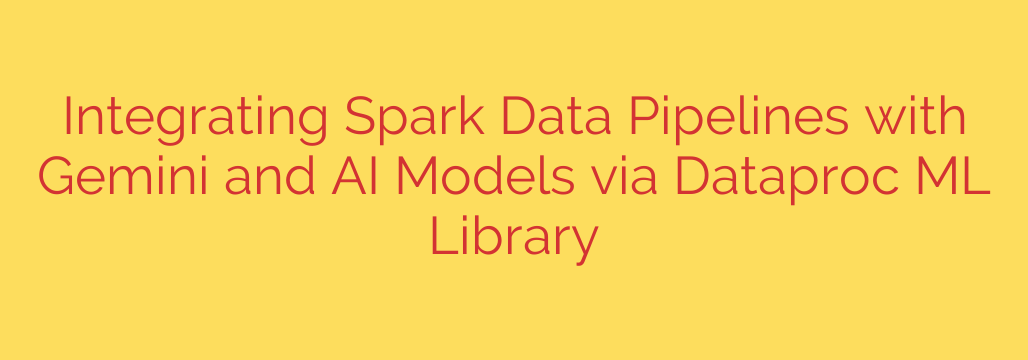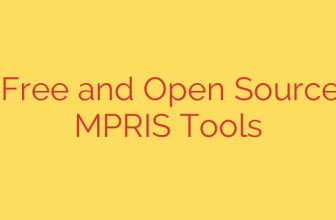
Supercharge Your Spark Data Pipelines with Gemini: A Guide to Scalable LLM Integration
Large Language Models (LLMs) like Gemini have revolutionized how we interact with and extract value from unstructured data. However, a significant challenge arises when a business needs to apply these powerful models to massive datasets—terabytes or even petabytes stored in a data lake. The traditional approach of exporting data, sending it to a model API, and importing the results is slow, costly, and fraught with security risks.
The core problem is data gravity. Moving vast amounts of data is inefficient. This process creates bottlenecks, racks up network egress costs, and exposes sensitive information outside of your secure environment. Fortunately, a new paradigm is emerging that brings AI capabilities directly to your data, enabling you to run Gemini inference at an unprecedented scale from within your existing Spark data pipelines.
The Bottleneck of Traditional LLM Integration
For any organization working with big data, the goal is to process information where it lives. When applying LLMs, the conventional method breaks this fundamental rule. Consider the common obstacles:
- API Rate Limiting: Most LLM APIs enforce strict rate limits, making it nearly impossible to process millions or billions of records in a timely fashion without complex and brittle orchestration.
- Network Latency: Sending data back and forth between your data processing environment (like a Spark cluster) and an external API endpoint introduces significant delays, crippling the performance of your entire pipeline.
- High Costs: Data egress charges can become exorbitant when dealing with terabyte-scale datasets. You are essentially paying to move your data twice—once out and once back in.
- Security and Governance Concerns: Moving data outside of your Virtual Private Cloud (VPC) or secure perimeter increases the risk of exposure and complicates compliance with data governance policies.
These challenges have historically made large-scale AI inference a task reserved for specialized, often cumbersome, MLOps platforms. That is, until now.
A Smarter Approach: In-Cluster Inference with Dataproc
The solution is to perform LLM inference directly on the worker nodes of your Spark cluster. By leveraging Google Cloud’s Dataproc ML library, you can now call the Gemini API from within a Spark job. This approach elegantly sidesteps the traditional bottlenecks by distributing the API calls across your entire cluster.
Here’s how it works: Instead of a single client trying to send millions of requests, each Spark executor becomes a client. The gemini-dask connector within the library intelligently manages this process by:
- Parallelizing API Calls: It uses a Dask backend to make concurrent calls to the Gemini API from every node in your cluster, dramatically increasing throughput.
- Automating Authentication: It seamlessly handles authentication, removing a major point of friction for developers.
- Managing Batching and Retries: The library automatically batches requests and implements an exponential backoff strategy for retries, ensuring your pipeline is robust and resilient to transient API errors.
This integration effectively transforms your Dataproc cluster into a massively parallel inference engine, allowing you to enrich your Spark DataFrames with insights from Gemini without ever moving the data.
Key Benefits of Integrating Gemini Directly into Spark
This modern architecture delivers transformative advantages for data engineering and machine learning teams.
Unmatched Scalability
By distributing the workload, you can apply Gemini to virtually any size dataset. Whether you are processing a few gigabytes or hundreds of terabytes, the architecture scales horizontally with your cluster. This finally makes it feasible to perform tasks like summarizing an entire library of corporate documents or analyzing a decade of customer reviews.Enhanced Performance and Efficiency
Keeping computation and data in the same place eliminates network latency and egress costs. Processing happens in parallel, drastically reducing the end-to-end runtime of your data pipelines. Jobs that might have taken days can now be completed in hours or even minutes.Simplified Development and Operations
The Dataproc ML library provides a simple, high-level Python API. Data engineers can integrate Gemini into a Spark job with just a few lines of code, using familiar constructs likemapInPandas. All the underlying complexity of distributed execution, error handling, and authentication is completely abstracted away.Improved Security and Governance
Perhaps most importantly, your data remains within your secure Google Cloud project and VPC. There is no need to export it to an external endpoint. This greatly simplifies security audits and ensures compliance with strict data privacy regulations.
Practical Use Cases for Scalable LLM Inference
Integrating Gemini directly into your Spark pipelines unlocks a wide range of powerful applications that were previously impractical at scale.
- Large-Scale Document Summarization: Analyze millions of legal contracts, financial reports, or research papers to extract key summaries and insights.
- Advanced Sentiment Analysis: Process vast streams of customer feedback, social media posts, or product reviews to gain a deep, real-time understanding of market sentiment.
- Automated Content Generation: Generate personalized product descriptions, marketing copy, or metadata for millions of items in an e-commerce catalog directly from raw data feeds.
- Complex Entity Extraction and Labeling: Sift through enormous unstructured text datasets to identify and classify specific entities, such as names, locations, or company-specific terms, to power knowledge graphs and analytics.
By bringing the formidable power of Gemini directly into the scalable, distributed environment of Spark, organizations can finally unlock the full potential of their data, no matter its size. This integration marks a significant step forward in the democratization of large-scale AI, enabling more teams to build sophisticated, data-driven applications with greater speed, security, and efficiency.
Source: https://cloud.google.com/blog/products/data-analytics/gemini-and-vertex-ai-for-spark-with-dataproc-ml-library/








